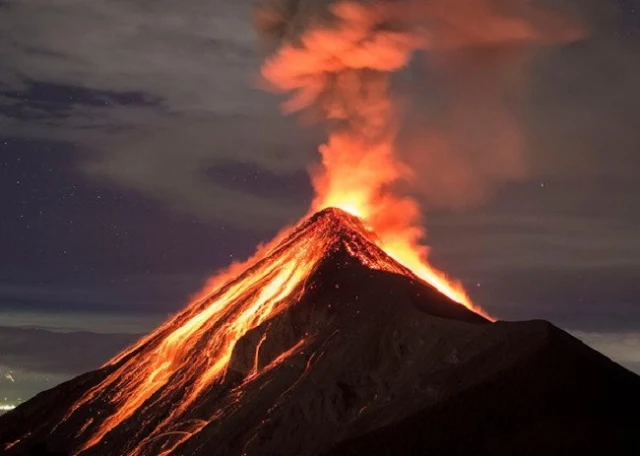
VietPress USA (Nov. 19, 2018): Today on Monday, Nov. 19, 2018, the Fuego Volcano erupts at sunrise in Escuintla of Guatemala, Central America. The Guatemalan Disaster Coordination Authorities have forced several communities in Guatemala to evacuate and go to safe areas after increased eruptions of the Volcano of the Fire destroyed again after more than 5 months from recent eruption on June 3rd, 2018 that killed 194 people dead, at least 300 injuries and 256 missing persons.
Authorities said that there are hundreds of deaths, many people missing and hundreds of injured persons but the exactly numbers are not confirmed yet.
According to Wikipedia, Volcán de Fuego (Spanish pronunciation: [bolˈkan de ˈfweɣo]; Spanish for "Volcano of Fire", often shortened to Fuego) or Chi Q’aq’”(Kaqchikel for "where the fire is") is an active stratovolcano in Guatemala, on the borders of Chimaltenango, Escuintla and Sacatepéquez departments. It sits about 16 kilometres (9.9 mi) west of Antigua, one of Guatemala's most famous cities and a tourist destination. It has erupted frequently since the Spanish conquest, most recently in June 2018.
The volcano is joined with Acatenango and collectively the complex is known as La Horqueta.
In 1881, French writer Eugenio Dussaussay climbed the volcano, then practically unexplored. First, he needed to ask for permission to climb from the Sacatepéquez governor, who gave him a letter for the Alotenango mayor asking for his assistance with guides to help the explorer and his companion, Tadeo Trabanino. They wanted to climb the central peak, unexplored at the time, but could not find a guide and had to climb to the active cone, which had a recent eruption in 1880.[9]
British archeologist Alfred Percival Maudslay climbed the volcano on 7 January 1892. Here is how he described his expedition
In 1623, Reported by historian Domingo Juarros. Caused damage in the surrounding area. It is possible the damage was related to earthquakes
27 to 30 August 1717: Strong eruption right before the San Miguel earthquake.
In 1732, Reported by historian Domingo Juarros. Caused damage in the surrounding area. It is possible the damage was related to earthquakes
In 1932, Strong eruption that covered Antigua Guatemala in ash.
15–21 October 1974: Strong eruption that caused heavy agricultural losses. Pyroclastic flows destroyed all vegetation in the surroundings of the active cone.
13 September 2012: The volcano began ejecting lava and ash, prompting officials to begin "a massive evacuation of thousands of people" in five communities.[15][dead link] More specifically, the evacuees, roughly 33,000 people, left nearly 17 villages near the volcano.[16] It ejected lava and pyroclastic flows about 600 metres (2,000 ft) down the slope of the volcano
8 February 2015: A further eruption resulted in 100 nearby residents being evacuated, and the closure of La Aurora International Airport due to the amount of falling ash.
On June 3rd, 2018, An eruption resulted in at least 194 deaths and at least 300 injuries, 256 missing persons and residents being evacuated, and the closure of La Aurora International Airport. The local communities have insisted there are thousands of missing persons.
Today on Monday, Nov. 19, 2018, the Fuego Volcano (Volcano of Fire) erupted again after 5 months from a strong eruption on June 3rd, 2018.
Read the news from The Independent on Yahoo News at:
VietPress USA News
oOo
Guatemala Fuego volcano eruption - as it happened: Thousands told 'evacuate immediately' as glowing lava appears at summit
Guatemala’s volcanology unit said that explosions from the 12,300-foot (3,763-metre) high mountain shook homes with “constant sounds similar to a train locomotive”.
Incandescent material burst as high as 1,000 meters (3,200 feet) above the crater and flows of hot rock and ash extended nearly 2 miles (3 kilometres) down one flank of the volcano. Hot blasts of pyroclastic material pushed down canyons on the slopes, while a column of ash rose nearly 23,000 feet (7,000 metres) above sea level and drifted towards Guatemala City to the east.
Hundreds of families heeded the call of disaster coordination authorities to evacuate 10 communities, piling into yellow school buses for trips to shelters. The national disaster commission said 3,925 people had been evacuated by early Monday.
The Volcano of Fire is one of the most active in Central America and an eruption in June killed 194 people. Another 234 are officially missing, although organisations supporting the communities have insisted there are thousands of missing persons.
It spewed more ash and hot rock in October, prompting warnings for the nearby communities.
The biggest danger from the volcano are lahars, a mixture of ash, rock, mud and debris, that can bury entire towns.
Residents living near the Volcan de Fuego in Guatemala were told to leave the area as a safety precaution on Monday, November 19, following eruptions.
This is the fourth eruption to take place this year. The last occurred in October, also prompting evacuations.
ooo
ooo






















